Reckitt Benckiser Group Bundle
How Does Reckitt Benckiser Dominate the Consumer Goods Market?
From Dettol to Lysol, Reckitt Benckiser (RB) is a household name, but how does this global giant stay ahead? This article dives deep into the Reckitt Benckiser Group SWOT Analysis, exploring its dynamic sales and marketing strategies. We'll uncover the secrets behind RB's impressive market share and its ability to adapt to ever-changing consumer demands.
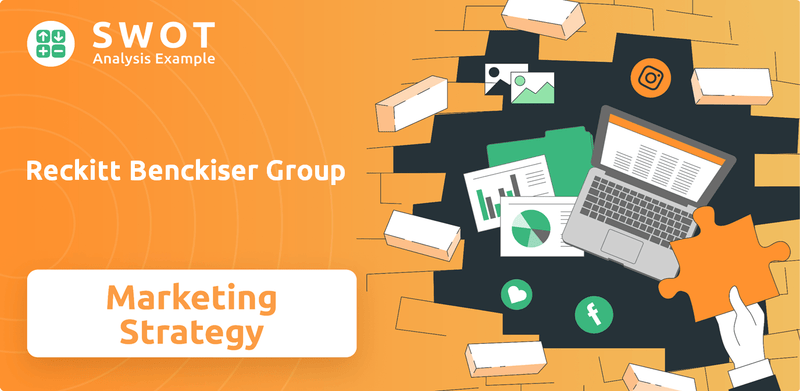
This comprehensive analysis explores the evolution of Reckitt Benckiser's sales and marketing strategy, from traditional retail to cutting-edge digital initiatives. We'll examine the RB product portfolio, dissecting how the company leverages its diverse brands to capture market share and drive sustainable growth. Learn how Reckitt Benckiser uses innovative marketing campaigns and strategic brand positioning to connect with consumers. Furthermore, we'll provide a deep dive into Reckitt Benckiser's market analysis, including sales performance reviews and future growth strategies.
How Does Reckitt Benckiser Group Reach Its Customers?
The sales strategy of Reckitt Benckiser (RB) involves a multifaceted approach to reach consumers globally. RB utilizes a wide array of sales channels, both online and offline, to ensure its products are readily available. This comprehensive strategy is designed to maximize product visibility and accessibility across diverse markets.
Traditionally, RB's sales have relied heavily on physical retail locations and wholesale distributors. These channels have been crucial in establishing a strong presence in supermarkets, pharmacies, and general stores worldwide. However, RB is also adapting to the changing retail landscape by focusing on digital adoption and e-commerce expansion.
The company’s sales and marketing strategy has been evolving, with a significant shift towards digital platforms and e-commerce. This transition is essential for reaching a wider audience and responding to the increasing trend of online purchasing. RB is optimizing its online platforms and strengthening partnerships with major e-retailers to increase product visibility and accessibility. For example, in China, e-commerce, including livestream channels, contributed to double-digit growth in 2024.
RB's offline sales channels include physical retail locations and wholesale distributors. These channels are essential for reaching consumers through established networks like supermarkets, pharmacies, and general stores. This approach ensures broad product availability and caters to consumers who prefer in-store purchases.
RB is actively expanding its e-commerce presence to capitalize on the growing trend of online shopping. This includes optimizing online platforms and partnering with major e-retailers. These efforts increase product visibility and accessibility, driving sales and market share growth in the digital space.
RB employs data-driven strategies to reach target consumers effectively. In Hong Kong, RB has seen significant sales growth through data and content-driven strategies, including partnerships with platforms like HKTVmall. These initiatives enhance brand engagement and drive sales.
RB is restructuring its business to focus on core brands and streamline operations. This includes potentially exiting the 'Essential Home' portfolio by the end of 2025. This strategic move aims to sharpen the focus on high-growth opportunities and improve overall performance. The company is reorganizing into three businesses: core Reckitt, Essential Home, and Mead Johnson Nutrition.
RB's sales strategy involves a mix of traditional and digital channels, focusing on both offline retail and e-commerce platforms. The company is also implementing data-driven marketing strategies to enhance consumer engagement and drive sales growth. These strategies are supported by strategic restructuring to focus on core brands.
- Offline Retail: Supermarkets, pharmacies, and general stores remain key distribution channels.
- E-commerce: RB is expanding its online presence through optimized platforms and partnerships with e-retailers.
- Digital Marketing: Data-driven strategies and content marketing are used to target consumers.
- Strategic Focus: The company is streamlining its portfolio to concentrate on core 'Powerbrands'.
Reckitt Benckiser Group SWOT Analysis
- Complete SWOT Breakdown
- Fully Customizable
- Editable in Excel & Word
- Professional Formatting
- Investor-Ready Format
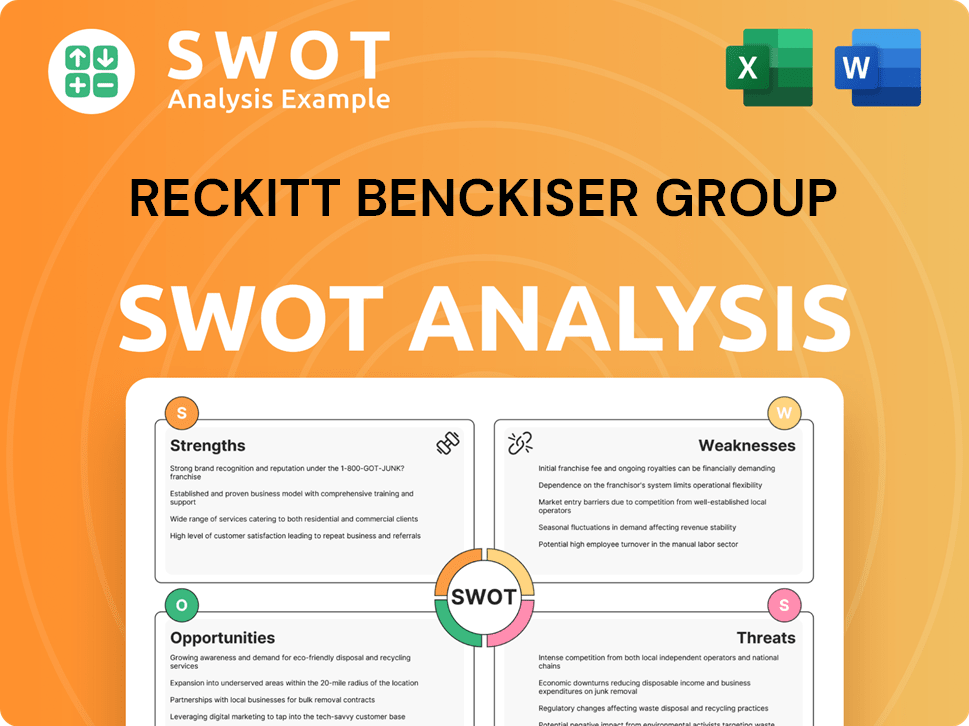
What Marketing Tactics Does Reckitt Benckiser Group Use?
The marketing tactics employed by Reckitt Benckiser (RB) are multifaceted, encompassing a blend of digital and traditional strategies to boost brand awareness, generate leads, and drive sales across its diverse product lines. This approach is crucial for maintaining and expanding its market presence, especially in competitive sectors like health, hygiene, and nutrition. The company's strategic marketing investments are tailored to resonate with consumers across various demographics and regions, ensuring a broad reach and effective engagement.
In 2024, Reckitt significantly increased its advertising spend in India, demonstrating a commitment to capturing a larger market share. This strategic move, combined with innovative digital campaigns and a focus on consumer insights, highlights Reckitt's dedication to adapting its marketing strategies to the evolving consumer landscape. The company's ability to leverage data and insights allows for highly targeted and effective marketing campaigns.
Reckitt Benckiser's sales and marketing strategy is a dynamic blend of traditional and digital approaches, aimed at maximizing consumer engagement and driving sales. This strategy is crucial for the company's continued success in a competitive market. To understand how Reckitt generates revenue, you can explore the Revenue Streams & Business Model of Reckitt Benckiser Group.
Reckitt Benckiser increased its advertising spend in India to an estimated Rs 1,900–2,100 crore in 2024, up from Rs 1,300–1,500 crore in 2023.
Reckitt has embraced digital transformation strategies to connect with digital natives and enhance operational efficiency, including investments in digital operations and consumer engagement tools.
Reckitt has found success in e-commerce through consumer-focused strategies, leveraging valuable insights from big data to understand consumer behavior and tailor content.
Reckitt turns shopper profile data into actionable insights that reshape advertising strategies, such as identifying consumer segments to build targeted content.
Net revenue from more sustainable products accounted for over a third of total revenues in 2024 (34.9%) compared to 29.6% in 2023.
Reckitt is integrating AI capabilities, such as the Dettol Banega Swasth India interactive AI-based bot, for hygiene education and personalized learning.
Reckitt Benckiser's marketing tactics include a mix of digital and traditional media, data-driven strategies, and a focus on sustainability.
- Digital Marketing: Utilizing content marketing, SEO, paid advertising, and email marketing to engage consumers.
- Traditional Media: Employing print media and radio, as seen with Dettol, to achieve broad reach and interaction.
- Data-Driven Personalization: Using consumer data to tailor advertising strategies and content, such as building content for specific consumer groups.
- Sustainability Integration: Aligning marketing efforts with sustainability goals, promoting more sustainable products.
- AI and Innovation: Integrating AI tools, like interactive bots, to provide education and personalized experiences.
Reckitt Benckiser Group PESTLE Analysis
- Covers All 6 PESTLE Categories
- No Research Needed – Save Hours of Work
- Built by Experts, Trusted by Consultants
- Instant Download, Ready to Use
- 100% Editable, Fully Customizable
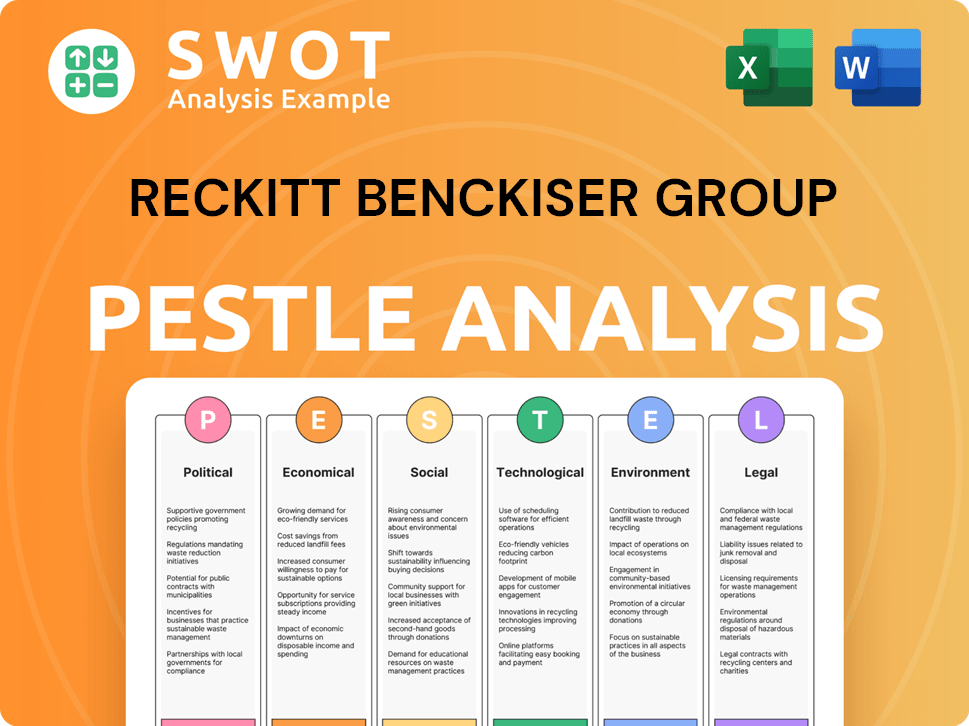
How Is Reckitt Benckiser Group Positioned in the Market?
The brand positioning of the company is centered on its mission to 'protect, heal, and nurture,' a message consistently communicated across its diverse product range. This core message is reinforced by strong brand recognition, especially with iconic brands like Dettol and Lysol. As of June 2024, the company's market capitalization was approximately $39.07 billion.
The company differentiates itself through innovation, proven effectiveness, and a growing emphasis on sustainability. This approach is designed to appeal to a broad consumer base, emphasizing both product performance and environmental responsibility. The company's marketing and sales strategies are closely aligned with its brand positioning, ensuring a consistent message across all channels.
The company's sales and marketing strategy leverages its strong brand recognition and focuses on consumer needs and preferences. The company invests heavily in research and development to stay ahead of consumer demands. The company's dedication to sustainability also enhances its brand attractiveness to an increasingly eco-conscious audience.
The company's brand identity is rooted in its purpose to 'protect, heal, and nurture.' This message is consistently conveyed across its health, hygiene, and nutrition products. This commitment is supported by a Brief History of Reckitt Benckiser Group, which highlights the company's evolution and brand building.
The company targets its audience through innovation, effectiveness, and sustainability. This approach appeals to consumers seeking both high-performing products and environmentally responsible choices. The company's marketing strategies are tailored to resonate with these values.
The company invests significantly in research and development to introduce new and improved products. This focus on innovation helps the company stay ahead of consumer needs and preferences. The company's sales strategy is supported by its commitment to product development.
The company's 2024 Sustainability Report highlights its focus on 'more sustainable brands, healthier planet and fairer society.' Net revenue from sustainable products accounted for over a third of total revenues in 2024. This includes reducing its carbon footprint and implementing eco-friendly practices.
The company's portfolio includes iconic brands such as Dettol and Lysol, which are globally recognized for cleanliness and protection. Dettol, for example, holds a significant market share in the antiseptic segment in India, exceeding 80%. The company is focusing on its 'Powerbrands,' which represent the essence of its growth potential.
- Dettol
- Lysol
- Mucinex
- Strepsils
- Gaviscon
- Nurofen
- Harpic
- Finish
Reckitt Benckiser Group Business Model Canvas
- Complete 9-Block Business Model Canvas
- Effortlessly Communicate Your Business Strategy
- Investor-Ready BMC Format
- 100% Editable and Customizable
- Clear and Structured Layout
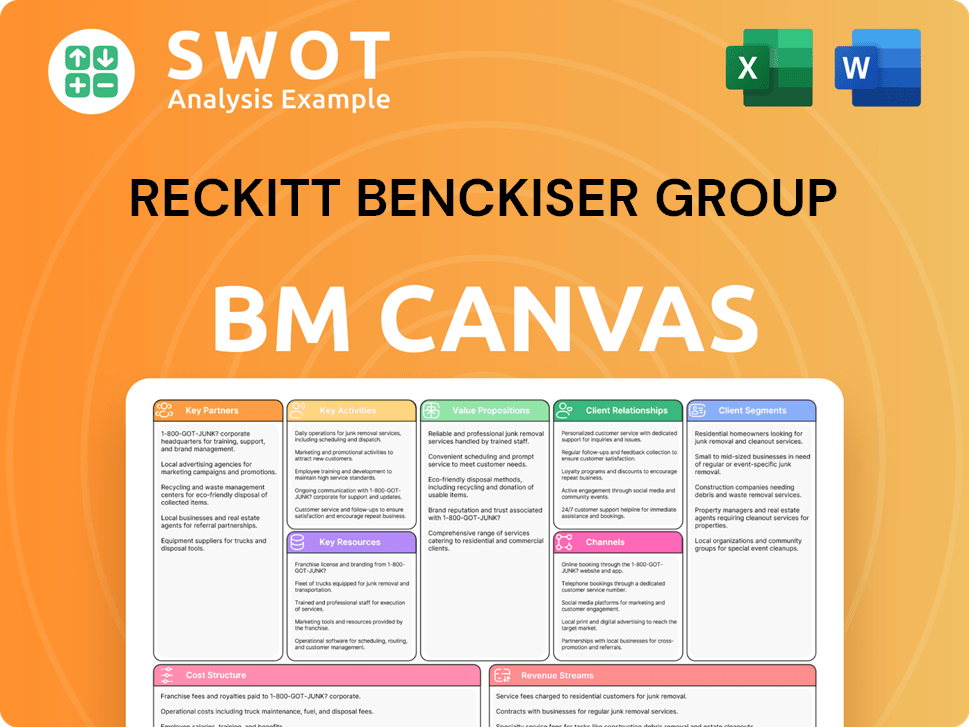
What Are Reckitt Benckiser Group’s Most Notable Campaigns?
Several impactful sales and marketing campaigns have significantly shaped the brand and driven growth. These campaigns often align with broader societal issues, showcasing a commitment to both commercial success and positive societal change. The company leverages its strong brand recognition and extensive reach to achieve these goals. Reckitt Benckiser's sales and marketing initiatives have demonstrated a comprehensive approach to consumer engagement and market penetration.
One notable example of a successful campaign is Nurofen's 'See My Pain,' which won the Grand Prix award at the Guardian Advertising Awards 2024. This campaign moved beyond traditional efficacy messaging to focus on emotional storytelling, addressing the gender pain gap. The campaign's success is evidenced by Nurofen growing its market share by 1 percentage point in a category that was down 3% year-on-year, securing £3 million in funding from the NHS for gender pain gap training for GPs, and the term 'gender pain gap' becoming the fastest-growing medical term on Google Trends. This illustrates how a well-executed marketing strategy can drive significant impact.
Another significant long-running campaign is Dettol's 'Banega Swasth India' (BSI) in India. This flagship initiative, which commemorated Global Handwashing Day 2024, educated 30 million children across India on the importance of handwashing for a healthier future. The campaign highlights Dettol BSI's commitment to providing essential hygiene knowledge to children from all backgrounds. Through partnerships with organizations like NDTV and Gramalaya, Dettol BSI has reached over 13 million people and engaged 30 million children across 29 states and 7 union territories in its school hygiene education program. The campaign has led to 82% of children reporting greater knowledge of preventing diarrhea. Dettol has also launched interactive AI-based bots to provide hygiene education and personalized learning experiences in multiple languages, and introduced Dettol Hygiene Parks to educate communities on best hygiene practices.
This campaign focused on emotional storytelling to address the gender pain gap. It won the Grand Prix award at the Guardian Advertising Awards 2024 and increased Nurofen's market share by 1 percentage point. The campaign's success highlights how addressing societal issues can boost brand performance.
This long-running initiative educated 30 million children in India on handwashing. The campaign has reached over 13 million people through partnerships and has led to 82% of children reporting greater knowledge of preventing diarrhea. It demonstrates a commitment to public health and hygiene education.
The campaigns aim to raise awareness, drive action, and promote positive societal change. They often focus on issues like the gender pain gap and public health, aligning with corporate social responsibility goals.
Partnerships with organizations like NDTV and Gramalaya have been crucial for reaching a wide audience. These collaborations help in delivering educational programs and expanding the reach of the campaigns.
The use of AI-based bots and interactive platforms provides personalized learning experiences. These digital initiatives enhance engagement and extend the reach of educational content.
Successful campaigns have led to increased market share and positive brand perception. The 'See My Pain' campaign, for example, saw a market share increase, demonstrating the effectiveness of purpose-driven marketing.
In October 2024, the company faced a penalty for unsubstantiated claims in advertisements, highlighting the importance of accurate messaging and compliance with competition laws. This underscores the need for transparency.
The company's strategy combines product promotion with social impact initiatives. This approach leverages brand recognition and extensive reach to achieve commercial success and drive positive societal change, fostering brand loyalty.
Reckitt Benckiser Group Porter's Five Forces Analysis
- Covers All 5 Competitive Forces in Detail
- Structured for Consultants, Students, and Founders
- 100% Editable in Microsoft Word & Excel
- Instant Digital Download – Use Immediately
- Compatible with Mac & PC – Fully Unlocked
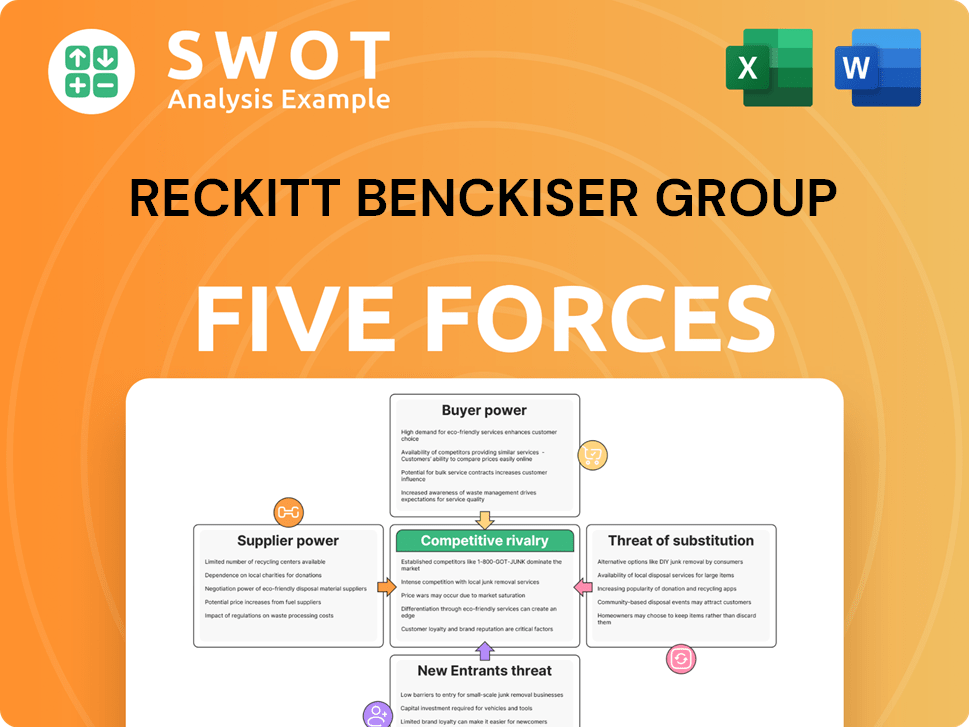
Related Blogs
- What are Mission Vision & Core Values of Reckitt Benckiser Group Company?
- What is Competitive Landscape of Reckitt Benckiser Group Company?
- What is Growth Strategy and Future Prospects of Reckitt Benckiser Group Company?
- How Does Reckitt Benckiser Group Company Work?
- What is Brief History of Reckitt Benckiser Group Company?
- Who Owns Reckitt Benckiser Group Company?
- What is Customer Demographics and Target Market of Reckitt Benckiser Group Company?
Disclaimer
All information, articles, and product details provided on this website are for general informational and educational purposes only. We do not claim any ownership over, nor do we intend to infringe upon, any trademarks, copyrights, logos, brand names, or other intellectual property mentioned or depicted on this site. Such intellectual property remains the property of its respective owners, and any references here are made solely for identification or informational purposes, without implying any affiliation, endorsement, or partnership.
We make no representations or warranties, express or implied, regarding the accuracy, completeness, or suitability of any content or products presented. Nothing on this website should be construed as legal, tax, investment, financial, medical, or other professional advice. In addition, no part of this site—including articles or product references—constitutes a solicitation, recommendation, endorsement, advertisement, or offer to buy or sell any securities, franchises, or other financial instruments, particularly in jurisdictions where such activity would be unlawful.
All content is of a general nature and may not address the specific circumstances of any individual or entity. It is not a substitute for professional advice or services. Any actions you take based on the information provided here are strictly at your own risk. You accept full responsibility for any decisions or outcomes arising from your use of this website and agree to release us from any liability in connection with your use of, or reliance upon, the content or products found herein.